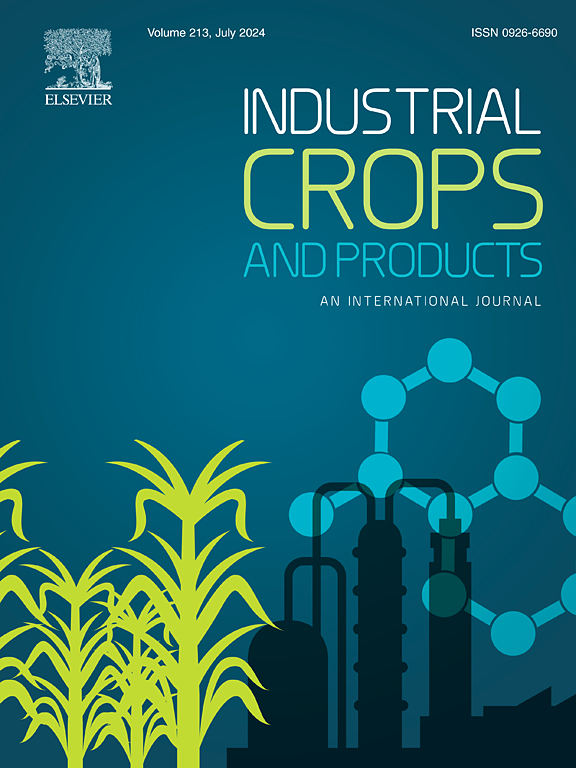靶向代谢组和转录组分析揭示了茉莉酸盐和黄酮类化合物调控银杏对高剂量NaCl胁迫的适应机制
IF 5.6
1区 农林科学
Q1 AGRICULTURAL ENGINEERING
引用次数: 0
摘要
银杏因含有黄酮等重要化合物而备受关注。我们之前的研究结果表明外源茉莉酸甲酯(MJ)可以提高银杏的耐盐性和类黄酮(Fla)的合成,但其内在机制尚不清楚。为了阐明茉莉酸(JA)、Fla和盐胁迫之间的关系,我们对银杏幼苗在MJ(250 μM MJ)、Na(150 mM NaCl)、Na+MJ(150 mM NaCl+250 μM MJ)处理下进行了综合转录组学(Tr)和野生靶向代谢组学(Me)分析。与Na处理相比,Na+MJ处理提高了POD和4CL酶活性,提高了槲皮素和总Fla水平,降低了MDA和H2O2水平。MJ或Na+MJ处理下,大部分差异表达基因(DEGs)的抗氧化酶(GST, APX)、Fla (FLS, F3'H)和JA (LOX, AOC)的生物合成以及植物激素信号转导(转录因子(TF)家族JAZ, MYC2, SAUR和bHLH相关基因)的表达均上调。Na处理也上调了部分基因(CCR)、SAUR和bHLH基因的表达。相应地,通过KEGG分析,在601种检测到的代谢物中富集了252种差异积累代谢物(DAMs)。与黄酮类化合物(异樱素和樱素)、JA和JA- ile相关的DAMs在三种处理下均显著上调,这些变化与FLS、F3'H、JAZ和MYC2基因的DEGs表达一致。然而,钠处理降低了脂肪酸和多胺合成中的大部分dam,而Na+MJ处理可以缓解这些dam的降低。这些结果表明银杏幼苗通过促进Fla和JA合成途径的基因表达和代谢物积累而具有一定程度的耐盐性。MJ的施用增强了银杏抗盐胁迫的能力。JA信号级联如MYC2和bHLH诱导类黄酮合成,后者反馈刺激JA合成。喷施MJ可作为促进盐碱地银杏类黄酮生物合成和增强其耐盐性的可持续策略。本文章由计算机程序翻译,如有差异,请以英文原文为准。
Targeted-metabolome and transcriptome analysis revealed the mechanisms by which jasmonate and flavonoids regulate Ginkgo biloba adaptation to high-dose NaCl stress
Ginkgo biloba L. has attracted much attention due to containing important compounds such as flavonoids. Our previous results ensured exogenous methyl jasmonate (MJ) could improve salt tolerance and flavonoid (Fla) synthesis in Ginkgo, while its intrinsic mechanism was still unclear. To elucidate the relationship between jasmonate acid (JA), Fla, and salinity stress, we performed integrated transcriptomic (Tr) and wild-targeted metabolomic (Me) analysis in ginkgo seedlings under MJ (250 μM MJ), Na (150 mM NaCl), Na+MJ (150 mM NaCl+250 μM MJ) treatments. The Na+MJ treatment enhanced the enzyme activities of POD and 4CL, elevated quercetin and total Fla levels, and reduced MDA and H2O2 levels compared to the Na treatment. Most of the differential expression genes (DEGs) were up-regulated in antioxidant enzymes (GST, APX), biosynthesis of Fla (FLS, F3’H) and JA (LOX, AOC), and phytohormone signal transduction (transcription factor (TF) family JAZ, MYC2, SAUR, and bHLH related genes) under the MJ or Na+MJ treatment. Na treatment also upregulated some gene (CCR), and SAUR and bHLH genes expressions. Correspondently, 252 differentially accumulated metabolites (DAMs) were enriched in 601 detected metabolites by KEGG analysis. The DAMs involved in flavonoids (isosakuranetin and sakuranetin), JA, and JA-Ile were significantly upregulated in the three treatments, and these changes coincided with the DEGs expressions of FLS, F3’H, JAZ, and MYC2 genes. However, Na treatment downregulated most of the DAMs in fatty acid and polyamine synthesis, and Na+MJ treatment could alleviate the decrease of these DAMs. These results suggest ginkgo seedlings have a degree of salt tolerance via promoting gene expressions and metabolite accumulations in the Fla and JA synthesis pathway. The MJ application enhanced ginkgo’s resistance ability to salinity stress. The JA signaling cascades such as MYC2 and bHLH induce flavonoid synthesis and the latter feedback to stimulate JA synthesis. Spraying MJ could be a sustainable strategy to promote flavonoid biosynthesis and enhance the salinity resistance of ginkgo in saline-alkali soil.
求助全文
通过发布文献求助,成功后即可免费获取论文全文。
去求助
来源期刊

Industrial Crops and Products
农林科学-农业工程
CiteScore
9.50
自引率
8.50%
发文量
1518
审稿时长
43 days
期刊介绍:
Industrial Crops and Products is an International Journal publishing academic and industrial research on industrial (defined as non-food/non-feed) crops and products. Papers concern both crop-oriented and bio-based materials from crops-oriented research, and should be of interest to an international audience, hypothesis driven, and where comparisons are made statistics performed.
 求助内容:
求助内容: 应助结果提醒方式:
应助结果提醒方式:


